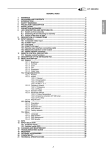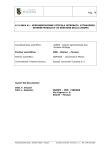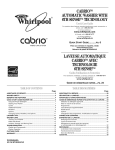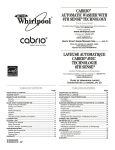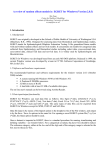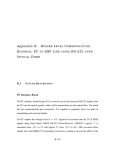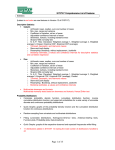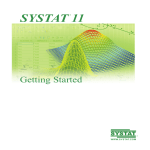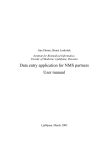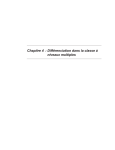Download Handling of missing values in statistical software packages for
Transcript
Eberle, Toutenburg:
Handling of missing values in statistical software
packages for windows
Sonderforschungsbereich 386, Paper 170 (1999)
Online unter: http://epub.ub.uni-muenchen.de/
Projektpartner
Handling of missing values in statistical software
packages for windows
W. Eberle
H. Toutenburg
September 23, 1999
Abstract
The problem of estimating parameters of distributions by an incomplete data set is theoretically considered, but in practice the implementation of the developed methods in commercial statistical software packages
varies from program to program. None of the examined software oers all
possible methods. In some programs the user has no choice concerning
the use of a method, or no methods at all are available. However, the
most popular programs have not always the largest variety of methods.
Hence some work is still waiting for the producer of statistical software.
1 Introduction
In most cases, the theory of statistical methods gives answers about what to
do if there is a complete data set. On the other hand, more often than we'd
like to the observations are incomplete. In the last years several people dealt
with the question of incomplete data and missing values. Indeed, Little and
Rubin (1987) give an extensive description about the theory of missing values
and how to solve this problem. In practice the statistical calculations are made
by software packages. While examining an incomplete data set it is important
to know how the program treats missing values and what tools are oered. This
paper presents the main results of an experience of several software packages
regarding the missing value problem. The results were obtained by a seminar
at the Institute of Statistics at the Ludwig-Maximilians-University Munich in
summer 1999. In the rst section of this report the examined software packages
are mentioned. The items which are considered are discussed in the second
section. And the third section presents the result of this investigation. The last
section contains a summary of the comparison.
2 Object of Analysis
In this investigation, the election of the statistical software packages was more
intuitive than calculated. The intention was to take that into the project which
is widespread in use but also more unknown programs as well. All the software packages are able to work with the operating system MS-Windows. As
mentioned above the title of this paper was theme of a seminar in which each
student had to examine one package. Therefore the number of elected software
1
MINITAB Release 12.2
SYSTAT 7.0 for Windows
STATISTICA/w 5.1.
Stata 6.0
S-PLUS 4.0
SPSS Release 8.0
SAS 6.12
StatXact Version 4.0
LogXact Version 2.1
JMP Version 3.15
Table 2.1: examined statistical software packages
was restricted by ten. The statistical software packages in the study are printed
in table 2.1.
3 Aspects of the investigation
The aim of this investigation was not only to answer the question of what the
program does when the data set is incomplete - that means the presentation of
missing values and oered methods for treating them etc. - but also how these
methods are documented in the online help and in the manuals. In the following
the central items of interest will be described.
The rst item concerns the missing data code. Each software package that
shall work with missing values needs a code to identify them. For the handling
of incomplete data sets it is necessary for the user to know how missing values
are coded. Some problems may arise if the code is unknown. Especially if the
code of the program and the code of the imported data set are not the same.
Then mistakes may arise while reading in the data.
Imagine the input data set uses a point as a symbol for the missing value, but
the program uses a blank. Then the missing value will not be recognized. As
a result, an error will arise if the variable is numeral or the column will be recognized as alphanumeral if there is a missing value in the rst observation. In
every case, the datasets in the program and the original are dierent.
Another mistake arises if the original dataset uses a number, -99 for example,
as a code for a missing value. The mentioned program reads the data without
problems, but when calculating some statistics the results will be wrong, because the original missing data code will be recognized as a number and not as
missing value and therefore will be included in the calculation. So the second
item concerns the existence of a desirable option that enables one to say how
missing values are coded in the original dataset and the program transforms it.
Sometimes there are some reasons for a missing value. This happens when
an individual refuses to answer or it passes some questions because of a certain
answer to a previous question (e.g. some questions are only for woman other are
only for man) a.s.o.. Now these dierent reasons shall be distinguished. Then
they need dierent codes but all these codes must be recognized as a missing
value by the program. The questions are: is it possible to dene more than
one value as a code for missing values?, or even better: does an option exist to
dene a whole area of values as missing value codes?
The fourth item concerns the representation of missing values in tables and
2
graphics. It is examined whether it is possible to create them when the data is
incomplete and how missing values are taken into account. In some cases it can
be choosen whether a new category shall be created. In other cases not even
the number of ignored observations is shown. Especially in time series several
methods can be applied.
Several statistical methods for incomplete datasets assume that the values
are missing completely at random (MCAR). That means the observed values
are as well as the missing values a random subsample of the sample set. So it is
necessary to test before using the method whether this assumption is fullled or
not. Therefore the following item deals with the question if the program oers
a test to assure MCAR.
A further item of the investigation concerns the calculation of descriptive
statistics in presence of missing values. Descriptive statistics means: mode, median, arithmetic mean, variance, standard deviation, skewness, kurtosis, standard error and quartiles. Here, the main interest are not the methods the
program oers because there is only one. It is examined if the program refuses
one of these actions because of missing values.
The calculation of covariance and correlation is seperated from the descriptive statistics because here is more than one variable involved. There are two
possibilities to handle missing values. The rst ignores all observations having
missing values in at least one of the variables. This is called complete case
analysis. The second takes only variables which are involved in the next calculation and ignores the observations with missing values. That is called available
case analysis. In the last case a problem sometimes arises when calculating a
correlationmatrix. Each element of this matrix represents a correlation of two
variables. If a dataset is incomplete the number of incomplete observations in
each pair of variables may not be the same and a dierent amount of observations is excluded from the calculation of the matrixelements. As a result,
the amount of observations for the calculation of the dierent correlations may
not be equal. Under this circumstances, sometimes correlations higher than
one or lower than minus one may arise. On the other hand, in some cases not
enough observations are left for a calculation by using the complete case analysis. Therefore it is desirable to have the choice between this two alternatives.
This question is dealt with by the seventh item.
The next item treats the oered options to calculate tests and condence
areas when there are missing values in the data and, of course, if it is allowed
to carry out these actions with incomplete data.
The handling of missing values by applying higher statistical methods such
as regression analysis, analysis of variance, cluster analysis, discriminance analysis and time series is also considered in this investigation. The results are put
into the ninth item. It is not the intention to explain here exactly the theoretical background of the used methods. Therefore several statistic literature exists
like Little and Rubin (1987) (as mentioned above), Rao and Toutenburg (1999),
Toutenburg (1992), etc. The used methods are EM-algorithm, interpolation,
extrapolation, imputation and some more.
3
Sometimes not all of the possible statistical methods are oered in every
software package, so it would be a good thing to have a programming language
to create macros for this special use. The next examined question concerns the
existence of a language to program macros.
All the questions above ask for the oered possibilities to deal with incomplete data sets, but it is also important to know how the program works. The
user should be informed about possibilities and options the program oers and
about the assumptions that may be satised to use a tool in the right way. This
information should be obtained by reading the manuals and the online help as
well. To judge their quality several items were subject of the investigation. First
of all it is examined whether and how the algorithms are explained. The second
item concerns the representation of the theoretical background. The manuals
and the online help should reveal the statistical background in a short way and
the user is able to refresh his knowledge about the method. If he wants a detailed information there should be given a list of further literatur. This is the
third item. The last item concerns examples which shall help to understand the
use of the oered methods and how these can be called. It must be remarked
that this judgement is not at all representative because each user may have
other expectations to manuals and online help.
The above mentioned items, which are considered at each statistical software
package in table 2.1, are listed in table 3.1. The results of the investigation are
represented in the following section.
4 Results of the Investigation
The rst considered software package is MINITAB Release 12.2. It is used
in science, industrie and economy in many countries all over the world. All
available procedures can be called by mouse click on the pull down menu or by
writing the command in the Session Window.
This program codes missing values in numeral and date/time variables with
a star as well. In alphanumeral variables the code is a blank. If a nondened
value arises while calculating a new variable the value is set as missing, too.
MINITAB is able to read datasets from external les which are created in
MS-Excel, Quatro Pro, Lotus 1-2-3 and dBASE but also text or data les. There
are no diculties while reading in data with a dierent code for missing values
from these les. MINITAB oers the option to change the code during or after
the reading in procedure. A probleme will only arise if a missing value in a
numeral variable is coded with a blank in the original data set. In this case
MINITAB is not able to dier whether it is a missing value or a separator. As a
result MINITAB ignores the missing value and reads the next value. Therefore
the MINITAB data set diers from the original because there are no missing
values and hence less observations. Here it is necessary to change the missing
value code before reading or use the option Import Special Text. There it is
possible to dene the format. The alternative for reading in an external le is
this: It is possible to enter the data via the command line editor in the session
window. There a missing value in a numeral variable must be writen with a
4
1. Coding of missing values
(a) in numeral variables.
(b) in alphanumeral variables.
(c) in data/time variables.
2. Existence of an option to change the code while reading an external
dataset.
3. Possibility of changing the code of missing values or dening several values
or even an area as missing.
4. Representation of missing values in
(a) tables and
(b) graphics.
5. Test on MCAR oered?
6. Possibility of calculating descriptive statistics in presence of missing values.
7. Oered options at calculating covariances and correlations.
8. Oered methods by applying tests and connence intervals.
9. Oered methods by applying
(a) regression analysis
(b) analysis of variance.
(c) cluster analysis.
(d) discriminant analysis.
(e) time series.
10. Possibility of programming macros.
11. Quality of manuals and online help:
(a) Explanation of algorithm?
(b) Presentation of the theoretical background?
(c) List of further literature?
(d) Quality and presence of examples?
Table 3.1: list of examined items
5
single quotation mark and a double in an alphanumeral variable. It is even
possible to edit the data in a worksheet directly. This is the easier way because
each cell is set as missing if no entry is made. MINITAB decides the type of
the variable while reading the rst row. If there is a missing value in a numeral
variable coded with a dot MINITAB puts it as alphanumeral.
An advantage of MINITAB concerns item three in table 3.1. This program
has an option to dene several codes as a code for missing values and even
several areas. The information about the number of observations and missing
values can be obtained for each variable in the Info Window.
In frequency tables the number of observations and missing values is presented if this action is called by the tally command with the option count. Otherwise it isn't mentioned. The option Cross Tabulation oers to choose whether
missing values shall be included or not or just for specic variables. If they
are included MINITAB creates an additional category for the missing values for
each variable that has one.
In this software package are two kinds of graphs: high-resoluted graphs (core
graphs, 3D graphs, speciality graphs) and character graphs. The rst oers
graphics with high quality and the possibility to make some changes. The second has the advantage that its graphics can be printed with every printer but
by far not as exact as high-resoluted graphs. If a character graph of a variable
with missing values is called, these will be ignored. High-resoluted graphs treat
this problem as follows. If the variable is categorial a new category for missing
values will be created. If it is a metric variable, points with at least one missing
value won't be plotted. In time series plots the point on both sides of a missing value will be connected with a straight line. Therefore the scale remains
the same. In every case, the number of ignored observations are written in the
Session Window.
A test that asures MCAR in the data set is not oered, but it is possible to
program a macro.
The calculation of descriptive statistics (as mentioned above) is possible with
two commands. The rst (describe) informs about the number of observations
and missing values, mean, minimum and maximum, median, standard deviation
and quartiles. The second (%describe) is a macro which gives no information
about the number of missing values, but it calculates additional variance, skewness, kurtosis and condence intervals a.s.o. and plots some descriptive graphics.
Several measurements can be called via the stats command or the menu bar.
The treatment of incomplete data is here very easy. All observations with a
missing value are excluded from these calculations.
This software package uses the available case analysis or the pairwise deletion
to treat missing values while calculating covariances and correlations as well.
There is no other possibility oered. Therefore it is possible to receive invalid
values in a correlation matrix as mentioned in the previous section.
For calculating inductive statistics such as tests and condence intervals
MINITAB uses only complete observations. That is observation with missing
values are excluded from the calculation. Only the 2 -test of independence
refuses incomplete variables.
In the regression analysis and the logistic regression incomplete observations
will be excluded from the calculations. In addition the regression analysis oers
the option to calculate tted values for the response if the independent variables
of the observation is complete. The output contains the number of excluded ob6
servations.
The problem of incomplete data in the analysis of variance treats MINITAB
as follows. Incomplete observations will be excluded from the calculation. Unfortunately the number of excluded or included observations won't be put out.
Sometimes a balanced design changes to an unbalanced. In this case the twoway-ANOVA produces an error message and no calculations will be made.
The cluster analysis in MINITAB oers two options. One tries to unite observations the other tries to group variables. In the rst case variables with missing
values can't be chosen in the dialog box. In the second case incomplete observations are excluded from the analysis and no information about the number of
included or excluded observations will be given.
If a discriminant analysis is called to an incomplete data set MINITAB excludes
all observations with missing values from the calculation. Here the number of
ignored observations is given in the output.
MINITAB has several procedures for calculating time series. These are moving average, trend analysis, decomposition and single and double exponential
smoothing. In each procedure it is possible to receive forecasts, but only the
rst three accept variables with missing values. These procedures do not ignore
incomplete observations - because this would cause a change of the time scale but still don't plot it. The output of each procedure contains the information
about the number of incomplete observations.
Of course, there are not all possibilities oered to handle incomplete datasets
but fortunately MINITAB enables the user to program macros. Therefore he
can write programs for his requirements.
To judge the quality of the manuals two books were considered. This is
the MINITAB User's Guide, which contains a clear overview of the structur
and usage of MINITAB, and the MINITAB Reference Manual, which informs
about all the possibilities of statistical calculations oered by MINITAB. Other
manuals are available such as MINITAB Quick Reference and MINITAB Mini
Manual which are only summaries of the two mentioned. The algorithms of
general statistical methods and methods for missing data are explained comprehensibly. The online help contains the same information. In addition to
that, the online help deals with the problem of reading in incomplete data sets
from external les. The statistical theory in the manuals is not as spread out
as in a school book, but users who have a certain knowledge of the statistical
background have a summary and repetition. It is especially explained when the
use of a special method is indicated. The theory of missing values is not given
but in many sections it is said what MINITAB does if missing values enter a
procedure. At the end of each chapter a list of literature for further information
about the theory is given, but there is no literature found for incomplete data.
For each procedure several clear and well explained examples are given, but
none for missing values.
The online help has no list of literature at all except the MINITAB documentation. It contains clear examples, but also such which explain how MINITAB
treats missing values. Therefore it possible to learn to work with MINITAB
without using the manuals. So the manuals explain MINITAB and its abilities
in a very clear way, but the information about the missing data problem is very
small. On the other hand there are only a view possibilities oerd to treat
missing values. The online help explications of the usage of procedures is more
extensive than that in the manuals but the theory is shorter. The manual has
7
no section about missing values. Therefore this subject is scattered, but all in
all it is a good reference book for the procedures.
The second examined software package is STATISTICA Version 5 Edition
'97. This is a version in german. All available procedures can be called by the
menu, but also via command lines. The data sheet is always visible. Here the
data can be entered directly. It is possible to write numbers and words into the
cells as well. STATISTICA denes for each word a number starting with 100.
Date and time values will be recoded in real numbers. So STATISTICA has
only to treat variables which are numeral. The code for a missing value is -9999,
but can be chosen between -9999 and 9999. In the data sheet this number will
not be shown, that means the cell is empty. In addition to that, the user is able
to dene this code for each variable separately.
The data can be read from dierent external les. These can be les which
are created with MS-Excel, Lotus 1-2-3, Symphony, Quattro, dBase, Paradox,
SPSS, SAS, Oracle, Sybase or ASCII-les. While reading in the data a modul
Datenmanagement recognizes their structure and converts all logical and text
variables and labes and empty cells into the STATISTICA format as well. Additional STATISTICA oers an option to change the code of variables or calculate
new variables. It is also possible to enter the data via clip board into the data
sheet, but in this case the data sheet must be extended at least to the size of
the data set which shall be imported. Otherwise only the rst ten observations
will be read in.
This software package has not the ability to dene more than one value or an
area as missing value. Therefore the user must be aware that in case of reading
in a data set with more than one code for missing value will cause a problem.
Either all missing codes will be recognized as misssing by STATISTICA - then a
distinction of dierent reasons for no value is impossible - or only one code will
be accepted and the other must be recoded afterwards via the Datamanagement.
This modul oers an option to replace missing values. There are two possibilities
for the replacement: mean imputation and weighted mean imputation where the
weights come from another variable. It is also possible to choose the observations
which shall be used for the calculation.
While creating tables, such as frequency or contingence tables, STATISTICA
enables the user to decide whether there should be a category for missing values
or not. This decision is not oered if graphics will be applied. Here the program
ignores incomplete cases and does not mention this. There is one exception: the
option Missing Data/Ausreisser-Plots produces a graphic where data points for
missing values are plotted. In addition to that, thresholds can be set and values
above and below them values are considered as outliers.
STATISTICA calculates each descriptive statistic without problems. The
number of observations, which are entered for the calculation, is shown. To call
for covariance or correlation matrices there exists the choice between casewise
and pairwise deletion.
If it is asked for tests and condence areas STATISTICA applies the available
case analysis.
In the regression calculations the dialogbox allows to choose between a listwise deletion and a mean imputation. Additional if multiple regression is called
a pairwise deletion can be elected. It is possible to use weigthed mean imputation, too. Therefore it is necessary to manipulate the dataset with the data
8
management tool before. For the cluster analysis and discriminance analysis it
is the same. Only the analysis of variance oers no choice. Here is always the
complete case analysis used.
For the analysis of time series it is necessary to have a complete dataset. If the
data contains missing values at the beginning or at the end of the time series
STATISTICA excludes these cases from further calculations. The remaining
holes can be lled by mean imputation or by the arithmetic mean of 2N neighbours where N can be chosen. If N exceed the time serie an error message
appears. Then the user has to elect a smaller N . STATISTICA oers the option to ll the missing values with the median of 2N neighbours. In addition
to that the program enables the user to elect regression imputation and linear
interpolation as method for calculating estimations for the missing values.
This software package has an own programming language at its disposal.
With STATISTICA BASIC the user is able to write his own macros.
The only delivered manual is STATISTICA Benutzerhandbuch. It has three
parts. The rst introduces how to use the program. It contains an index where
it is possible to nd a section about missing data. There are the treatments
of incomplete data listed, but not explained and it is not said which method is
used at each procedure. Here it is refered to the online help. The second part
gives an overview about the statistical methods. Here it is somewhat dicult
to nd a place where treatments of incomplete data is mentioned. In fact, only
in the section of correlation matrices the problem of missing values is discussed.
The last part contains several example, but examples of dealing with missing
values are sparse. The manual has no bibliography and some literature is only
given at a few places.
In comparison with the manual the online help is much more extensive, concerning the part one and two, and deals mainly with the use of STATISTICA
and the statistical theory. There is much more literature listed where further
information about the theory can be found. In addition internet links can be
called and connect StatSoft. In the home page of Statsoft one can nd additional macros. The algorhythms are given neither in the manuals nor in the
online help.
SYSTAT 7.0 enables the user to start the procedures either via pull down
menu or via icons or via the Command Editor. It distinguishes between two
types of data: numeral and alphanumeral (strings). SYSTAT marks missing
values in numeral variables with a dot and in alphanumeral with a blank.
This program is able to open data sets from dierent les. These are SPSS,
spreadsheet, database or ASCII les. It is possible to import all rows and
columns or just a range by entering the number of the rst and the last case or
column. In ASCII-les missing numerical data is agged by a dot and missing
character data is marked by a blank which is enclosed within quotation marks.
If this is forgotten SYSTAT cannot recognize the missing values and errors will
arise. SYSTAT interprets each line as a row. Therefore the next observed value
will be put at the place of the missing and the case has empty cells at the end
of the row. Furthermore, it is not possible to change the coding while reading
in the data. The user must change it after or before the import. The last is
indicated when missing values are coded with a character, but in general, no
problems appear while importing data from external les. Besides neither it is
possible to dene several values, an area nor another value as code for a missing
9
value. The code is x.
A table can be extended with an additional category for missing values by
using the command 'Include missing values'. In graphics incomplete observations will be ignored and no information is given about this action. It is not
even mentioned how many observations are included for the graph. Only if a
new category for missing values is dened, before they will be plotted.
Calculating descriptive statistics for one variable is carried out by ignoring
missing values. To calculate Pearson's correlation coecient, the covariance
or the sum of squares of the cross-products of deviation (SSCP), the user can
choose from one of the following methods: EM-algorithm (for metric variables),
listwise or pairwise deletion. When the pairwise deletion is chosen to calculate
the SSCP matrix each result is weighted with the quotient of the number of
rows and the number of observations which enter the calculation for each matrix
element. If the EM-Algorithmn is used the output contains information about
the number of iterations and the missing pattern. Furthermore, it is possible to
control the number of iterations, the convergence criteria and the inuence of
outlier. In addition estimations of mean and correlation matrix is given and a
test on MCAR is carried out.
Tests and condence intervals are calculated by ignoring incomplete observations. There is one exception. The 2 -test for independence oers the option
to include missing values in an additional category.
The regression analysis of SYSTAT treats missing values as follows. It
doesn't matter if the missings are in the independent or dependent variables
each incomplete case will be omitted. The output informs the user about the
ignored cases. In the analysis of variances, the cluster analysis and the discriminant analysis, SYSTAT treats this problem treats in the same way. In the
cluster analysis the manual recommends to create a new category for missing
values with a binary coding. Then the option 'Join' can be used to clearify
whether there is a missing data system. In time series SYSTAT has two options
for treating missing values. Either they will be omitted or they will be estimated
by a distance-weighted least square interpolation (DWLS-interpolation).
\DWLS interpolates by locally quadratic approximating curves that are weighted
by the distance to each nonmissing point in the series. With this algorithm, all
nonmissing values in the series contribute to the missing data estimates, and
thus complex local features can be modelled by the interpolant"(SYSTAT Statistics).
In each case incomplete observations at the beginning or the end of the serie
will be ignored.
The 'Delete'-option works as follows:"Retain only the leading nonmissing values
for analysis. In series that begin with one or more missing values, the series is
deleted from the rst missing value following one or more nonmissing values.
This option enables you to forecast missing values from nonmissing subsection
of the series"(SYSTAT Statistics).
These forecasts can be inserted into the series before repeating the procedure
later.
SYSTAT enables to write small programs, but no macros. These programs
must be imported into the command window and submitted.
There are ve books which document the use of SYSTAT. These are Data,
Graphics, Statistics, New Statistics and Command Reference. Data contains
introductory information about SYSTAT. All books except the Command Ref10
erence have in each chapter an introduction and a table of contents. At the end,
an extensive list of literatur is given. The manuals are clear. Key words are
placed on the margin and dierent fonts are used. The theory is only explained
in a short way. It is assumed that the user already has the knowledge of the
procedures which must be recalled. Clear examples support the explanation
of the procedures. Methods for missing data especially the EM-Algorithm is
explained extensively and problems are mentioned. On the other hand, not all
of the procedure descriptions mention the treatment of missing values. The
online help is clear, because of the dierent fonts, but is not as extensive as the
manual. A list of further literatur is not given. The topic 'missing values' is
only mentioned in time series and correlation calculation.
Stata 6.0 is one of the less known software packages in Germany, but in english speaking countries its use is more spread out. According to the statements
on the homepage of Stata, the advantages of this program are high speed calculation and easy handling even for statistic beginners. This release is designed
as a window program but its graphical surface is heavy reduced. There are
no dialog boxes, icons or pull down menus to call a statistical function. Every
command must be entered into the Stata-Command-Window. Several other
windows exist: the Data-Result-Window containing the output, the VariablesWindow containing a list of all variables, the Review-Window containing the
executed commands, the Data-Window for showing the data set, the StataEditor for editing the data set, the Do-File-Editor for programming procedures
and the Graph-Window, which contains the graphical output, but only showing one graphic. A new graphic deletes the old one. Some graphics having an
ASCII format are less exact (e.g the histogram). Stata oers a wide range of
tests and estimation methods with several options but therefore the commands
are sometimes pretty long.
Stata marks missing values in the data sheet with a dot in numeral and a
blank in alphanumeral variables. If the data will be entered directly into the
data sheet the cell which is not edited in a variable is set as missing. If an ASCII
le is read in a missing value in a numeral variable must be marked with a dot
and in alphanumeral variables with two quotation marks. In addition to that, all
\things that are not understood ... are mentioned and stored as missing values"
(Getting started with Stata for windows (1999)). Missing values are coded with
the highest number. As a result, if the number of individuals with an income
of more than 5,000 is called, observations without entry in the corresponding
variable will be counted, too. This is important if categories will be created. If
one knows this it is possible to exclude missing values from creating categories.
Not dened calculations and calculations with missing values lead to a missing
value. In this case Stata gives a message that missing values are generated. It
is not possible to dene individual areas or several values as code for missing
values. There are only a few types of variables available with a specic amount
of numbers (e.g. byte, int, long, oat, double). Each value beneath the chosen
amount will be recognized as a missing value.
In tables the number of missing values is not shown except if using the
command inspect which enables the user to see the number of missing values.
Furthermore, the use of the inspect-command results in a mini histogramm in
the text mode in which it is possible to see a rough guess of the amount of
the missing values. Even the number of observed values is only sometimes
11
mentioned. Graphs ignore missing values. The only way to make these visible
is to dene a new category. In time series it is necessary to estimate the missing
values to avoid holes in the graph.
Stata oers no test on MCAR, but it has an option to check the data set
for two kinds of dependences. Firstly, if there is a missing value in variable a
then there is a missing value in variable b, too, and vice versa. Secondly, if a is
missing then variable c has a missing, but not vice versa.
Descriptive statistics will be calculated by omitting missing values. Only the
correlation can be calculated by a complete case or an available case analysis.
Stata oers three methods to ll up an incomplete dataset. Firstly, it is
possible to use the regression imputation. Here are at least 31 complete observations necessary. In addition to that, the variance of the estimation will be
calculated. Compared to STATISTICA the completed variable is stored in a
new variable, therefore the old variable is still visible. Secondly, it is possible
to ll up a missing value by linear interpolation and third by linear inter- and
extrapolation. In tests, regression analysis, analysis of variance, cluster analysis, time series and others, there are these three methods in addition to the
complete case analysis possible. A discriminant analysis is not available. It is
possible that in time series the moving average leads to missing values caused
by incomplete data. This can be supressed by the nonmiss-command but it is
not explained how it works.
This software package has a language to program macros and procedures
which can be stored as Ado-Files. The explanations in the manuals are often
not enough for understanding. Furthermore, it is possible to put them into the
homepage of stata and to get some out of it.
For this examination there are seven manuals considered. These are Getting started with Stata, the Stata Graphics Manual, the Stata User'S Guide and
four Stata Reference Manuals. The algorithms are explained in most cases and
important formulas for tests are given. The statistical theory is given for important functions at least. Each chapter has a list of further literatur where
the user can nd the statistical background which is left out in the manuals.
Examples are given to all procedures, but it is very often assumed that the data
set is complete. Therefore there are only a few examples for the treatment of
missing values. Stata oers two possibilities to receive help. Firstly, after entering a command and calling the help an extensive explanation of this command
is given. Secondly, if the online help is called a word can be searched, but the
result is only a list of chapters in the manuals. In addition the user can get
further information via internet. Either he calls the homepage of Stata or he
mails his problem. The homepage oers many les for downloading and many
texts about Stata.
The software package S-PLUS is based on the S-Language which has some
elements of C/C++ and even of other programming languages. It is possible
to modify existing procedures. Furthermore, a menu bar is given with which
actions can be started via dialogboxes. In S-PLUS, several windows exist. There
is an Object Browser which contains all objects of the current working directory.
Here the objects can be edited. The functions and commands will be entered
into the Command Window which containing the text output, too. Graphs
appear in seperat or in the same Graphsheet, which is optional. All submitted
commands are shown in the History Window, so they can be repeated. A Report
12
Window will be opened if a function is called via menu bar and contains the
text output. A missing data is coded with 'NA' in numerals and data/time
variables. Alphanumeral variables are not allowed. In this case numbers must
be entered and labels must be dened. Data can be imported from dBASE,
Excel, FoxPro, MS-Access, Paradox and text les but also les from SPSS and
SAS. Missing data will be recognized and recoded. If there is a self dened
code for missing values it is possible to change it into the S-PLUS format while
reading the data. A possibility to dene several values or an interval as code
for a missing data is not given. An advantage of S-PLUS are the functions
for missing values. There are commands to create a vector to a variable which
shows by boolean whether a value is missing or not. Furthermore, a vector can
by created out of a variable by omitting all missing entries. And the observation
number can be demanded where a cell of a variable is empty. There is also a
function which counts the incomplete cells of a variable. In addition to that a
functions exists which creates missing values within a complete vector according
to a equal distribution on 0 1]. Here the user can select how much observation
shall become missings. S-PLUS has an option with which can be chosen whether
missing values shall be placed on the top, on the bottom or be omitted in the
sort or order function.
While frequency tables are requested S-PLUS oers two possibilities to treat
missing values. Firstly, it ignores observations with missing values in the demanded variable. Secondly, a new category for missing values will be created.
In cross tabulations is one more option available: the action will be refused.
Additional it is possible to program new options. S-PLUS oers several types
of graphs. Missing values in simple line plots results in a broken graph. In
histograms missing values will be omitted. There is no option to choose. Pie
charts will only be plotted for complete variables. The only way to receive a
graphic is dening missing values as an own category. There are two functions
to create normal QQ-Plots. The rst (qqnorm) ignores missing values. The
second (qqline) refuses the action. A test on MCAR doesn't exist.
If descriptive statistics are required S-PLUS omits missing values and it is
possible to show their number. In calculations of covariance and correlation
four option are available. Firstly, a complete case analysis will be performed.
Secondly, an available case analysis can be chosen. Third the action will be
refused, because of missing values. And fourth in matrices elements which will
be calculated by incomplete variables are set as missing.
The calculation of tests and condence intervalls excludes missing values.
The only exception is the 2 -test for independence. It refuses the action if a
variable is incomplete.
The treatment of incomplete data in regression analysis is the same as in
the analysis of variances. Here an error message appears, but this is optional.
It is also possible to omit missing values or replace them with the arithmetic
mean. The regression analysis replaces only missings in the independent variables. Observations with missing values in the response are excluded from the
calculation. The cluster analysis and the discriminant analysis allow no missing
values. In Classication and Regression Trees (CART) all observations with
missings values in the response will be excluded. Furthermore, there exists an
option with which a new factor variable can be created with an own class for
missings. Another option transforms metric variables into factors. In survival
analysis missing values will be excluded or an error message appears which is
13
optional. Missing values in time series are just allowed at the beginning and at
the end. If a value is missing in the center an error message appears. In ARIMA
models missing values will be treated with methods based on Kalman-lter.
It is remarkable that the manuals Guide to Statistics, User's Guide and
Programmer's Guide are available in the online help and an entry to the MathSoft and S-PLUS hompage as well. The Language Reference oers an extensive
help to the available functions for missing data. There are detailed information
about their abilities, warnings and references to similar functions and further
literature. Some examples are given, too. Though it is not mentioned in which
statistical function they can be used. Here it is necessary to consult the help for
the statistical methods. There are the optional arguments for treating missing
values and their function is explained in a short way. But there is no hint that
there is a special help page for missing value functions where the arguments will
be explained extensively. The examples are mostly with complete data sets, so
there are in general no examples with missing values in the help for the statistical methods. In addition some possibilities to treat incomplete data sets
are not mentioned. For example the online help for linear models has no tip
to the function which enables a mean imputation. These information can be
found in the Guide to Statistics. Other arguments for treating missing values
are simply given in the help page for the function in which they can be used.
There the explanation is clear and extensive. The Guide to Statistics mentions
arguments for missing data treatment in the statistical functions in a short way.
Only \Classication and Regression Trees", \Survival Analysis" and \Time Series Analysis" have an own section for this problem. Additional, in the last
algorithm and methods are explained in a short way. The S-PLUS-Help/User's
Guide mentions the missing data problem simply with one sentence refering to
the page of the function, which is interesting, in the Language Reference. The
only german book for S-PLUS in this survey Einfuehrung in S und S-PLUS has
sections for missing data and their coding, but these are not at all extensive. In
general, examples are not explained in the online help.
The following software package is one of the most widespread in Europe. It
oers the user a comfortable analysis of his data via pull down menu and icons,
but also via command editor. SPSS has a modular feature. That means that it
consists of a ground version and several additional moduls. One of them is the
MVA-modul (missing value analysis). In the version 8.0 it is included. For the
earlier version it must be bought seperately.
First of all the ground version distinguishes two kinds of missing values. On
the one hand, the System Missing Value which is coded with the decimal sign
of the country, using a dot in the english version and a comma in the german,
in numeral and date/time variables. A System Missing Value exists if no valid
entry is made in a cell of the data sheet. System missing values in alphanumeral
variables don't exist. Even a blank is a valid sign. On the other hand, the user
dened missing value. There are three possibilities to dene missing value codes.
Either the user denes up to three discrete numbers, one area or one area and
one discrete number. This can be made for each variable separately. It can be
dened missing values in alphanumeral variables, too. Here up to three words
are allowed to be chosen as missing value codes.
SPSS is able to import data sets from several types of les. These are
bBASE, Excel, FoxPro, MS-Access Paradox and text les. It is also possible
14
to read in ASCII les. Here can be chosen between the options 'Freeeld' and
'Fixed Columns'. In both cases no missing value can be recoded. That means
the user can say what type of variable there is in the data set and what the
name of the variable is, but all values which do not match with the type of
variable will be set as System Missing Value and the user receives a message.
Recoding values in a variable is possible when the data set is read in. There the
user can choose if the result shall be written in a new variable or overwrite the
old.
The ground version of SPSS distinguishes two kinds of missing data treatments. The treatment before and while calling a specic procedure. Treatments
before the analysis means either to delete a variable if it is not in the main interest of the study and it contains many missings, or the other method, which
is also mentioned in the manuals, is to impute guessed values. The user can
decide between ve options. Firstly, there is the mean imputation. Secondly,
the imputated value can be calculated from the mean or thirdly the median
of the next 2n observed values where n can be specied. It must be remarked
that a system missing value is set if not enough neighbours exist. Fourthly,
the guessed value is received from linear interpolation or fthly from the linear
trend. The last works as follows: For all observed values a linear trend line will
be calculated. The missing value will be replaced by the value of this trend line
at its place. Of course, for the last four methods the data set must be put in
an order. It can be decided if the lled variable shall replace the old or form a
new one. In the rst case the original variable is lost in the temporary data set
and the danger of deleting this while saving it, exists. It should be mentioned
that the system missings and the user dened missing values will be replaced
as well.
Frequency tables show the frequency of all values that means all values inclusive the user dened missing values and the system missing values. Additional
the percentage is given for all values und for the valid values, too. The cummulative percentage is only given for the valid cases. In crosstabulation the
listwise deletion is used. In all kinds of graphs there are the options to select
listwise or pairwise deletion. Furthermore, the user can decide whether missing
values shall appear in an extra category or not. Line plots oer also an option
to interpolate missing values and therefore repair the line. If a frequency statistic is called it is possible to view a graph. Three types are available. The bar
chart and the histogram omits missing values. The latter is only for numeric
variables. The pie chart counts user dened values twice. On the rst place it is
united in missing values and on the second a piece for each value is plotted. It
must be remarked that user dened intervals for missing values are not counted
twice.
SPSS has no problem to calculate descriptive statistics of variables with
missing values. The output contains allways the information about the number
of excluded observations. This software package oers three kinds of correlation
the bivariate, the partial and the distances correlation. In all it is possible to
delete listwise deletion and in the two rst mentioned the user can select the
pairwise deletion, too. The MVA-modul calculates the number of missing and
nonmissing values, mean, standard deviation and extreme values. Means, covarince matrix and correlation matrixwill be estimatied using listwise, pairwise,
EM or regression methods.
In all kinds of tests it can be chosen between listwise and pairwise dele15
tion. The regression analysis enables the user to elect either listwise or pairwise
deletion or mean imputation to deal with incomplete data. The used method
is mentioned in the output. The analysis of variance allows listwise and pairwise deletion and so it is in cluster analysis. The numbering of cases in the
cluster analysis is somehow confusing, because it is not identical to that of the
datasheet. The reason is: incomplete observations will be omitted and the complete cases get new serial numbers. The discriminat analysis allows only listwise
deletion or mean imptutation. Missing values at the beginning or the end of
time series are allowed and deleted from the analysis. If a empty cell exists in
the center of it the calculation stops at this point and the time serie is only
plotted till there.
As mentioned above SPSS has a modul to analyse missing values. The
Missing Value procedure performs three primary functions. Firstly, to describe
patterns of missing data. This includes the answers to the following questions.
Where are the missing values located? How extensive are they? Tend pairs of
variables to have values missing in dierent cases? Are data values extreme?
And are values missing randomly? Secondly, to estimate means, standard deviations, covariances and correlations using a listwise, pairwise, regression or
expectation-maximization method (EM method). The pairwise method also
displays counts of pairwise complete cases. Thirdly, to ll in missing values
with estimated values, which will be obtained by using regression or EM methods (SPSS Missing Value Analysis 7.5).
For examining the missing data pattern of a data set the modul oers three types
of pattern tables. The 'Tabulated cases' shows the frequency of each missing
value pattern. Counts and variables are both sorted by similarity of patterns.
In addition to that, an option is given to eliminate patterns that occur in less
than a chosen percentage of cases. The output table contains an additional column in which the user can see how the number of complete observations would
increase if a specic variable is deleted. The option 'Cases with missing values'
show case-by-variable patterns of missing and extreme values for cases that have
missing values. Cases and variables are both sorted by similarity of patterns.
The 'All cases' option displays for each case the pattern of missing and extreme
values. Here the missing values are distinguished in system missings and the
dierent user dened missing values. It is possible to sort them according to a
specied variable. The criteria for an extreme value is the same as for boxplots.
Univariate statistics can be calculated. That means for each variable the number of nonmissing values, the number and percentage of missing values, and
the count and percentage of missing values are displayed. Additional, for metric variables the mean, the standard deviation and the counts of extreme high
and low values are shown. Three options are oered to examine possible missing data pattern. Therefore SPSS creates internal for each variable a missing
indicator variable that indicates whether the value of a variable is present or
not. The 'Percent mismatch' option creates a table in which for each pair of
variables the percentage of cases with one variable having and the other having
not a missing value. Each diagonal element contains the percentage of missing
values for a single variable. The second option compares for each quantitative
variable the means of two groups using Student's t statistic. The t statistic, degrees of freedom, counts of missing and nonmissing values and means of the two
groups are displayed. It is also possible to \display any two-tailed probabilities
associated with the t statistics, although interpretation of these probabilities
16
can be problematic" as the manual SPSS Missing Value Analysis 7.5 mentions.
With the t test can be decided whether values are missing randomly or not. The
MVA-module oers \Little's 2 -statistic for testing whether values are missing
completely at random"(SPSS Missing Value Analysis 7.5). This will be only
calculated with the EM methods and output with the EM matrices. The third
option displays a crosstabulation of categorical and indicator variables, that
means a table for each categorical variable in which for each category (columns)
the frequency and percentage of nonmissing values for the other variables (rows)
is shown and the percentage of each type of missing value, too.
The means, the standard deviations, the covariances and the correlations can
be caluculated via listwise and pairwise deletion, regression estimation and EM
algorithm as well. In case of the pairwise deletion a table of frequency of missing
values in pairs of variables is shown. All variables are listed and the number of
pairwise complete cases are shown. In case of the regression estimation missing
values are estimated using multiple linear regression. The means, the covariance matrix and the correlation matrix of the predicted variables are displayed.
Here it is possible to add a random component to regression estimates. It is
possible to choose between residuals, normal variates, Student's t variates or no
adjustment. A maximum number of predictor variables can be set, too. In case
of the EM method several assumptions can be made for the distribution of the
data. These are normal, mixed normal and Student's t distribution. For the
mixed normal assumption the proportion and the standard deviation ratio can
be specied. For the Student's t distribution the degrees of freedom must be set.
Furthermore, the number of maximum iterations can be specied after which
the calculation stops (it doesn't matter if it has converged or not). In both cases
of lled up data sets these can be saved via an additional option. If the data is
missing completely at random all four methods provide consistent and unbiased
estimates for the covariances and correlations. Besides, the MVA-module oers
a summary of means and standard deviations which are calculated by dierent methods. Here the results can be compared. The manuals recommend to
calculate scatter plots of the original variables and the completed for proong
whether the estimated values t to the observed values.
SPSS has an own programming language. The commands can be entered
into the Syntax Editor and submitted or a macro can be programmed. Using
the syntax commands the user has some more possibilities to analyse data sets.
Indeed this is dierent within the MVA-module. Here all commands can be
applied via dialog boxes, too.
There is an extensive literature available for SPSS and its additional moduls.
These are generally written in English but some of them are translated into German, French, Italian and Spanish. The manuals have clearly structured chapters. Each chapter explains the use of a specic procedure and oered options.
Its use is shown by concrete examples. At the beginning of a chapter the goal
of the described method is told. Afterwards the statistical background is mentioned in a short way and shown by an example. Then the way these methods
and its options can be called in SPSS is described and shown by clear examples.
Additionally, the examples contain an interpretation of the results. Unfortunately, the algorithms are not explained. Further literature can be found in the
bibliography at the end of the manual. The books are mentioned in the text.
Therefore if the user wants on overview about the literature to the topic of a
chapter he must read the whole chapter and mark the mentioned books.
17
The online help oers the user only some short informations about the goal of a
specic procedure, but there are no information about algorithm and statistical
background. On the other hand it is very clearly explained how the procedure
can be called. The syntax of the commands are given but unfortunately the
options are not explained. An additional item in the online help leads the user
to the web page of SPSS where informations can be read or questions can be
posed. There are also web pages in dierent languages, but these contain only
short information and refer to the american page.
The next considered software package is SAS in its release 6.12 . SAS is also
a rather popular program especially in medical researches. If a new medicine is
developed its eect must be proofed and whether there are any undesired side
eects. Finally, the study results are sent to an institution which decides if a
medicine may be sold. A leading institution is the american Food and Drug
Administration. This wants the data in an SAS format. Therefore the use of
SAS is assured.
SAS is a program whose user surface is not as comfortable as that of SPSS
for example. Besides, it oers a wide range of methods to analyse data sets
and create reports. If SAS is called three windows will be opened. The Log
- Window, the Output - Window and the Program Editor. Procedures can be
carried out by tipping the commands into the Program Editor and to submit
them. The icons in the SAS window enable neither a statistical analysis nor the
creating of graphs. One icon activates the SAS/Assist. It is a less comfortable
tool to carry out actions via dialog boxes as the surface of SPSS. The user has
to spend some time to nd out how he can run the chosen procedures which is a
disadvantage. Finally the program should be as simple in use as possible. The
user might work with it without consulting manuals.
SAS distinguishes two kinds of variable types: character and numeric. The
numeric type contains also date-,time- and some more formats. Several formats
are united to the character type, too. A missing value in a charachter variable
is coded with a blank. The code in numeric variables is a dot. Nonnumerical
cell entries in a numeric variable will be set as missing. Results of calculations
which are not dened are set as missing, too. The code is x and cannot be
changed. SAS allows neither the denition of more than one value nor of an
area of values as missing values.
SAS can import data from text les. Here it is possible to choose a given
le format, that means data les in which values are separated by commas or
by tab deliminater, or a user dened le format. Equal which format is elected
it is not possible to change the code of a value while reading in the data if the
action is called by dialog boxes. Therefore missing values have to be recoded
before or after reading the data. If the data is read in by syntax commands
the user has more options. Usually the variables are of a special type. If this
is dened no other type can be entered into the cells of the variable. That
means a numeric variable allows no characters. SAS oers an option with which
characters are allowed in numeric variables. But in calculations these characters
will be regarded as missing values. This can be used to distinguish several
reasons for nonresponding. SAS is also able to read data sets from MS Excel
and BMDP les.
Frequency tables and crosstabulations can be called by the PROC FREQ
procedure. The default adjustment ignores missing values, but writes the num18
ber of excluded observations in the output. Two alternatives are oered. Firstly,
a new category for missing values will be created for each variable with missing
values, but only their number is printed in the table. Missing values are not included in culculations of statistics. The second alternative includes additionally
the missing values in statistical calculations.
This software packages supports dierent kinds of graphics which will be calculated by several procedures. Graphs for categorical values, these are pie charts,
block charts, bar charts, etc., enables to create an additional category for missing values which is plotted in the graph. Other procedures omit incomplete
observations. In time series two possibilities are given. Either the plot stops at
the rst missing value after an observed or missing values will be interpolated
by four methods. The cubic spline ts the data inside the rst and the last
observed values. Additionally, the spline is extended by adding linear segments
at the beginning and the end. The linear interpolation connects the observed
value before and after the missing value. \The STEP method ts a discontinuous piecewise-constant curve. For point-in-time input data, the resulting
step function is equal to the most recent input value. For interval total or average data, the step function is equal to the average value for the interval." \The
aggregate method performs simple aggregation of time series without interpolation of missing values. If the input data are totals or averages, the results are
the sums or averages, respectively, of the input values for observations corresponding to the output observations. If the input data are point-in-time values,
the result value of each output observation equals the input value for a selected
input observation."(SAS online help).
For calculating tests or condence intervals SAS ignores incomplete cases.
The regression analysis in SAS omits all incomplete observations. In general
linear models that can be calculated by the PROC GLM-procedure the treatment of missing values depends on the type of analysis. If an univariate model is
elected observations with missing values are omitted equal the value is missing
in the response or in the independent variables. In case of multivariat models
two possibilities are availabe. Either an observation will be excluded of the
whole calculation if a value is missing in at least one of the response variables
or it is excluded from the calculation of the considered variable if it has no valid
value in this variable. The number of used or excluded observations will not be
given in the output. If a probit model is calculated by the PROC PROBITprocedure missing values in the response are treated as zero. The observation
will be excluded if the independent variables have at least one value missing.
The analysis of variances ignores any observation with missing values.
SAS distinguishes two cases in cluster analysis.\If the data are coordinates, observations with missing values are excluded from the analysis. If the data are
distances, missing values are not allowed in the lower triangle of the distance
matrix. The uppertriangle is ignored."(SAS/STAT User's Guide).
Missing values in discriminant analysis are treaten as follows.\Observations with
missing values for variables in the analysis are excluded from the development
of the classication criterion. When the values of the classication variable
are missing, the observation is excluded from the classication criterion, but if
no other variables in the analysis have missing values for that observation, the
observation is classied and printed with the classication result."(SAS/STAT
User's Guide).
In time series any missing value at the beginning of the data set will be skipped.
19
An option can be specied, then \the rst continuous set of data with no missing
values is used otherwise, all data with nonmissing values for the independent
and dependent variables are used. Note, however, that the observations containing missing values are still needed to maintain the correct spacing in the time
series. For output data sets, PROC AUTOREG can generate predicted values
when the dependent variable is missing."(SAS online help). Another procedure
is available to t "cubic spline curves to the nonmissing values of variables to
form continuous-time approximations of the input series. The procedure can
also estimate rst derivatives of time series with respect to time, computed by
dierentiating the interpolated spline curve."(SAS online help).
The concept of this program bases on syntax commands as entirely mentioned. Therefore it should be easy for an experienced SAS user to program his
own procedures or macros.
The quality of manuals is considered by the SAS/STAT User' Guide and the
SAS/GRAPH Software. The rst chapter of the User's Guide describes the idea
and the theory of statistical methods in a short way. Sometimes an example is
given to make the things clearer. In these chapters the user can nd all available
procedures of this context with a short describtion of its work. Additionally, the
chapter in which the procedures are explained is named. In addition to that,
a list of further literature is given. The following chapters describe the procedures extensively. The abilities of the procedures are mentioned. The syntax
and the options are explained clearly. Several examples are given with a short
explanation of the output. In addition to that, each of these chapters name the
treatments of missing values in the procedures. Algorithms are not explicitely
mentioned. The user can only guess it by reading the theory.
The online help is not as extensive as the manuals. Here neither the theoretical
background nor the algoritms are mentioned. Only the idea and the syntax of
the commands and its use is described. Sometimes an example is given which
are not as clear as those in the manuals. Furthermore, it is not easy to nd
something specic, because there are several references to one item and each
of the new opened pages contains another information. Sometimes it would be
easier for the user if all information of one item is united in one page.
The next software package is made for exact nonparametric inference. \The
goal of StatXact is to enable statisticans and data analysts to make reliable inferences by exact and Monte Carlo methods when their data are sparce, heaviliy
tied, or skewed, and the accuracy of the corresponding large sample theory is in
doubt. . . . If a data set is too large for the exact alhorithms, StatXact computes
Monte Carlo estimates of the exact p-values to any desired accuracy. If the data
set is too large for both . . . , it is almost certainly large enough for asymptotic
theory to work accurately."(StatXact User Manual). In general this program
doesn't expect missing values. There is only one command which assigns to an
observation of a variable the number one, if this observation is missing and zero
otherwise. It is always expecting complete data sets. Indeed the data can be
incomplete. Missing values will be coded with a dot in numeral and alphanumeral variables as well. But incomplete observations will be excluded from all
calculations.
StatXact allows to import data les created by other software programs. It
can read in data that are in ASCII Data, BMDP Data, BMDP New system,
EGRET Data, EXCEL Data, dBASE Data, LOTUS 1-2-3 Data, SAS Transport
20
Data, SPSS Data, STATISTICA Data or SYSTAT Data format. Missing values
will be recognized and recoded into the StatXact code. It is not planed to change
any variable while reading in the data. Of course, it is possible to transform
variables afterwards. Furthermore, the user cannot dene missing values neither
one or more values nor a whole area of values. As mentioned above, StatXact
is a program for inferences. Therefore graphics cannot be made, but the results
can be stored in a le in a format that other programs can create a graph out
of it. In tables the number of excluded observations is never mentioned. Only
the number of used observations is mostly said in the output. The calculation
of descriptive statistics for incomplete data sets is no problem for StatXact,
missing values will be omitted. If descriptive statistics will be calculated the
option 'count' carries out the number of included cases. This program oers
no test on MCAR, but many other in which the available case analysis is used.
Other statistics like regression analysis, cluster analysis a.s.o. are not oered.
This software package has own commands to read in data, to store results or
to transform variables, but it is not possible to write procedures. The syntax is
easy to learn by the manuals.
The manual StatXact For Windows: User Manual is additionally stored in
a le. If the user uses the index to nd something about missing values he will
be refered to one place in which only the treatment in the data editor is described. Besides, while reading the book one may nd some explications about
how StatXact deals with missing values in descriptive statistics and variable
transformations. The manual discusses the theory extensively sometimes more
than statistical literature. Examples are given to make it clearer. References
are given but only at the end of the book and none at the end of each chapter.
Caused by the sparce abilities to deal with missing values this problem is hardly
mentioned. The online help is actually no help concerning missing values, because the search for these words leads to no result. In general the online help
explains the use of the dialog boxes and the oered options. The search for
algorithms, statistical theory or even literature fails. Furthermore, examples to
the commands are not to nd. All in all it is easy to navigate.
The following software package oers only exact methods for binary logistic
regression analysis. LogXact is made from the same corporation which programmed StatXact. It \performs unconditional maximum likelihood inference,
conditional maximum likelihood inference, and conditional exact on the parameters of the logistic regression model."(LogXact User Manual). In case of larger
data sets asymptotical methods can be elected. Usually missing values are coded
with a dot equal if it is within a numeral or alphanumeral variable. It is interesting that this program in compare with StatXact is not able to read character
variables from text les. It is also impossible to change the code while reading
in the data. These must be done before or after importing. Each character in
numeral variable is set as missing value. In addition to that, missing values
in SYSTAT data les will not be recognized or recoded to the system missing
value code of LogXact. This program provides to import data set from ASCII
Data, BMDP Portable Data, BMDP New System Data, EGRET Data, SAS
Transport Data, SPSS PC+ Data and SYSTAT Data les.
In the global options dialog box the user can dene a number within the
interval ;1 1025 1 1025 ] as missing value code. This denition is valid in
the whole data set. It is not allowed to dene more than one value or even an
21
area of values. If a data set is imported after dening this missing value code
all values with this value will come in as a missing value.
In tables of the output the number of used observations is outlined. Graphics
can not be made. As mentioned above only logistic regression analysis can
be performed. Therefore other analysis will not be treated. In fact not even
descriptive statistics are oerd. Only a cross tabulation can be performed. In
each case LogXact uses the available case analysis to deal with incomplete data.
As StatXact, LogXact has some commands to carry out some data management actions, but it is not possible to create own procedures.
The manual LogXact User Manual explaines the statistical theory as extensive
as that of StatXact. Some examples help to make it more clear. Algotithms are
not mentioned. Furthermore, references can be found in the end of the manual.
The online help is as well as that of StatXact. The only dierence between them
is the fact that LogXact's online help knows the expression 'missing value'. The
user will then be refered to the missing value codes which can be elected. A
disadvantage are the hardly given examples.
Finally the software package JMP in its version 3.15 was considered. JMP
is a program from SAS Institute Inc. and was produced for analysing smaller
data sets. It oers the main methods for graphic plots and inductive statistics.
For extensive analysis of the data the manual recommends to use SAS. The
advantage of JMP compared to SAS is easy handling and easy learning, because
of the comfortable dialog boxes. On the other hand it has no programming
language to write procedures.
JMP codes missing values in numeral variables with a question mark. In
alphanumeral variables it uses a blank. The narrow connection to SAS can be
seen if one looks for external les to import. Only text or SAS transport les
can be read in. In text les the type of a variable will be recognized by the
rst row. In numeral variables all nonnumeral signs will be set as missing value.
Only blanks will not be noticed. In this case the value of the next column will be
taken. Therefore the whole row is moved and the last variables have missings.
In alphanumeral values only blanks will be set as missing values. JMP oers no
tool to recode values while reading in data. In addition to that, it is impossible
to change the code for missing values or to dene several values or an area of
values as missing code.
In frequency tables an own row for missing values is printed. In cross tabulations no category for missing values is given. The number of excluded observations must be calculated from the dierence of the number of all observations
and the included. In graphics missing values will be omitted without a message.
A test on MCAR is not oered.
For calculations of descriptive statistics JMP omits missing values. If correlations and covariances are called the user can choose between complete case
and available case analysis.
JMP excludes all incomplete observations concerning the interesting variables from the calculations of tests or condence intervals. Regression, cluster
and discriminant analysis and analysis of variance use the available case analysis for dealing with incomplete data sets as well. In time series only observed
values are plotted and connected with a straight line.
The considered literature is resticted to three manuals: the Introductory
Guide which \is a collection of tutorials designed to help \ learning JMP strate22
Table 4.1: Explanation of abbreviations used in table 4.2
c
a
cc
sv
ar
nCat
lInt
lExt
mI
wmI
regI
MedoN
MoN
MC
Kalman
cSpl
DWLS
complete case analysis (listwise or case wise deletion)
available case analysis (pairwise deletion)
change of missing value code possible
several values can be dened as code for missing values
an area of values can be dened as code for misssing values
a category for missing values will be created
linear Interpolation
linear Extrapolation
mean imputation
weighted mean imputation
regression imputation
median of 2N neighbours imputation
mean of 2N neighbours imputation
Monte Carlo methods
methods based on Kalman lter
cubic splines
distance weighted least squares interpolation
gies. The User's Guide which has a \complete documentation of all JMP menus,
an explanation of data manipulation, and a description of the calculator." The
Statistics and Graphics Guide \documents statistical platforms, discusses statistical methods, and describes all report windows and options". The statistical
theory is described and explained by clear examples. The interested reader may
nd further literatur in the references at the end of the Statistics and Graphics
Guide. Algorithms are not mentioned.
The online help gives no answers to algorithms. The statistical theory is not
described. Sometimes the idea is mentioned. The user will not nd any literature. Fortunately the use of the online help is rather clear and comfortable. On
the other hand only a few topics are given to missing values. But this is caused
by the few possibilities JMP oers for treating this problem.
23
24
yes
+/+
+/+
yes / no
++ / ++
10
111(a)
(b)
(c)
(d)
a
c,a6 ,mI,wmI7
c
c,mI,wmI)7
c,mI,wmI7
mI,lInt,regI,
MoN,MedoN
yes
{/{
0/+
no / yes
++ / 0
no
yes
c,a
S-PLUS
NA
Table 4.2: Comparison of statistical software packages. For explanation of the items and abbreviations see table 3.1 and 4.1 respectively.
c3
c
c4
c5
c
lInt
no
yes
a
8
9 (a)
(b)
(c)
(d)
(e)
5
6
7
c,nCat
a
c,nCat
c,nCat2
4 (a)
(b)
Stata
.
blank
SPSS
SAS
StatXact LogXact JMP
.
.
.
.
?
blank
blank
.
.
blank
NA
.
.
no
yes
no
yes
no
no
no
no
cc
sv,ar
sv
no
cc18
no
ar+value
c,nCat
c
c,nCat,refuse c13 , nCat14 c,nCat17
c
nCat
c
c
c,refuse
c,nCat,
c,nCat
c
a,lInt
yes
no
no
yes15
no
no
no
no
yes
yes
yes
yes
yes
yes
yes
c,a,
c,a
c,a,
c,a,
c,a
c
c,a
EM8
refuse
EM15 ,regI15
c9
c,regI,lInt,lExt
c3
c,a
c
a,MC
c
c
c,regI,lInt,lExt c,mI,refuse
c,a,mI
c
a
a
c
c,regI,lInt,lExt c,mI,refuse
c,a
c
a
c
c,regI,lInt,lExt
refuse
c,a
c
a
c
refuse
c,mI
c
a
c,DWLS c,regI,lInt,lExt c,refuse11 ,
c,stop11
c,lInt,lExt,
a
Kalman12
stop11 ,cSpl
no10
yes
yes
yes
yes
no
no
no
+/0
+/{
0/0
016 / {
0/{
{/{
{/{
{/{
0/0
+/{
0/+
+/{
++ / {
++ / { ++ / {
+/yes / no
yes / no
yes / yes
yes / no
yes / no yes / no yes / yes yes / no
++ / +
++ / {
+/0
++ / ++
+/0
++ / - ++ / - ++ / +
MINITAB STATISTICA SYSTAT
*
-9999
.
blank
-9999
blank
*
-9999
yes
no
no
sv, ar
cc
no
item
1 (a)
(b)
(c)
2
3
5 Summary
This survey has shown that the missing value problem is treated very dierently
even in this small selection of statistical software packages. Some of the smaller
programs as JMP, StatXact and LogXact have no idea to deal with missing
values, except to omit incomplete observations. Here is not even a progamming
language oered to remove the lack of methods by the user. LogXact enables
only to change the missing value code. JMP merely creates a new category for
missing values in tables. LogXact and StatXact allow to choose the code for
missing values out of star, dot and question mark while exporting a data set.
SYSTAT is somehow more comfortable than these three, because here the user
has sometimes a choice how incomplete data shall be handeled. Amazingly, it
oers an EM-Algorithm for calculating correlation matrices, but easier methods
like imputation methods are not at all considered. Additionally, the programming of macros is not provided. Therefore it is not possible to program any of
the missing methods. The explanation of the EM-Algorithm is quite extensive
and SYSTAT is able to carry out a test on MCAR what is not at all taken for
granted. Only SPSS oers this test in its additional MVA module. Apart from
that, the statistical background is only mentioned in the manuals in a short way.
All the other software packages have a programming language on its disposal to
write macros and remove the lack of methods for missing value treatment. The
more popular program MINITAB enables the user to dene his own missing
value codes, either as several discrete values or as an area of values. In addition
to that, SPSS oers the user to dene an area and one discrete value. MINITAB
oers only complete case and available case analysis and in time series linear
interpolation to handle incomplete data. References to literature which deals
with missing values are not given. SAS is compareable with MINITAB. In most
cases the complete case analysis is used, but in time series several methods are
oered and the statistical background is explained very extensively in the manuals. S-PLUS oers mean imputation to ll up incomplete data what is necessary,
because quite often actions will be refused because of missing values. This program is the only one which oers a method based on Kalman lter to deal with
missing values in time series. Furthermore, it has many functions for missing
values, but no examples are given and no information about the treatment of
incomplete data sets is available in the online help. STATISTICA and Stata
manuals / online help
only in categorical variables in high-resoluted graphs
-test for independence refuses incomplete variables.
if the two-way-ANOVA design changes to unbalanced an error message arises.
c if variables will be clustered. If observations will be clustered MV are not allowed.
in multiple regression
this action must be carried out with the data management before
for metric variables
-test for independence enables to include missing values in a new category (optional)
possibility to write programs
if missing values are in the center of the time series
in ARIMA-models
only in line plots
user dened missings are listed separately
with the MVA-module
in a special book about numerical algorithms
it can be decided whether missing values are included in calculations of statistics or not
the change of the code is valid for all variables
1
2
3 2
4
5
6
7
8
9 2
10
11
12
13
14
15
16
17
18
25
are also compareable in its abilities to deal with missing values. Both have several imputation methods in addition to the complete case and the available case
analysis. On the other hand it is impossible to dene several values or an area of
values as missing value code. Only STATISTICA allows to change the system
missing code for each variable and the user may decide whether a new category for missing values in tables shall be created or not. Besides Stata enables
imputation methods in calculations of tests and condence intervals but oers
no discriminant analysis. The statistical theory of the methods is explained in
a rather short way or missing. SPSS without its additional MVA module has
many procedures to treat incomplete data. Several imputation methods are
oered which must in most cases be carried out by data transformation before
applying statistical analysis. The user can also dene codes for missing values in
more than one way. With the MVA module, which is especially for incomplete
data sets, SPSS allows to examine the missing value pattern and the system
which possibly causes the nonresponding. Therefore it is the most comfortable
program in this selection.
To sum up one must say that the problem of missing values is recognized,
but considered in a dierent intensity within the examined software packages.
The perfect program was not in this survey. Hence, it should be an incentive
for all to enlarge the abilities for the missing value problem.
6 Bibliography
D. Altman (1997): Practical Statistics for Medical Research, Chapman & Hall,
Weinheim.
K. Backhaus, R. Erichson, W. Plinke, R. Weiber (1996): Multivariate Analysemethoden, Springer Verlag, Berlin, Heidelberg.
G. Bamberg, F. Baur (1991): Statistik, Oldenburg Verlag 7.Auage.
Bankhofer, Hilbert (1997): Statistical Software Packages for Windows: A Market Survey, Statistical Papers 38: 393-407.
G. Brosius, F. Brosius (1998): SPSS Base System und Professional Statistics,
Fuer die Versionen 5.x und 6.x, Bonn: International Thomson Publishing 2.
Auage.
A. Buehl, P. Zoepfel (1995): SPSS fuer Windows 6.1, Praxisorientierte Einfuehrung in die moderne Datenanalyse, Bonn: Addison-Wesley 2. Aufalge.
J.M. Chambers, T.J. Hastie (1992): Statistic Models in S, Wadsworth and
Brooks Cole.
CYTEL Software Corporation (1996): LogXact For Windows: User Manual.
CYTEL Software Corporation (1996): StatXact 4 For Windows: User Manual.
26
T.R. Dawber (1980): The Framingham Study: The Epidemiology of Atherosclerotic Disease, Harvard University Press, Boston.
FDA, Food and Drug Administration, 2867fnl.pdf, www.fda.gov/cder/guidance.
A. Fieger, H. Toutenburg (1994): SPSS (fuer Windows) Tables: Arbeitsbuch
fuer Praktiker, Muenchen: Prentice Hall.
A. Fieger, H. Toutenburg (1995): SPSS Trends fuer Windows: Arbeitsbuch
fuer Praktiker, Muenchen: Prentice Hall.
T. Hahl, R. Shelton: Dropping Variables That Have Only Missing Values, Observations Vol. 5, No. 4, The SAS Institute, v5n20pp1.html .
J. Hartung, B. Elpelt (1992): Multivariate Statistik, Oldenburg Verlag, Muenchen.
H. Kahn, C. Sempos (1989): Statistical Methods in Epidemiology, Oxford.
A. Krause (1997): Einfuehrung in S und S-PLUS, Springer Verlag.
R. Little, D. Rubin (1987): Statistical Analysis with Missing Data, John Wiley
& Sons, New York.
S-PLUS 4, Guide to Statistics, Mathsoft (1997).
S-PLUS, User's Guide, Version 4.0, Mathsoft (1997).
S-PLUS, Programmer's Guide, Version 4.0, Mathsoft (1997).
MINITAB User's Guide, Release 11 for Windows (1996).
MINITAB Reference Manual, Release 11 for Windows (1996).
C. R. Rao, H. Toutenburg (1999): Linear Models: Least Squares and Alternatives, Springer Verlag, New York.
SAS Institute (1995): JMP Version 3.1 Introductory Guide, SAS Institute Inc.
SAS Institute (1995): JMP Version 3.1 User's Guide, SAS Institute Inc.
SAS Institute (1995): JMP Version 3.1 Statistics and Graphics Guide, SAS
Institute Inc.
SAS Institute (1990): SAS/STAT User's Guide, Version 6, SAS Institute Inc.
SAS Institute (1990): SAS/GRAPH Software: Reference, Version 6, SAS Institute Inc.
SPSS Inc. (1993): SPSS Base System User's Guide Release 6.0, Mary Ann
Hill: SPSS Inc.
27
SPSS Inc. (1997): SPSS Missing Data Analysis 7.5, Mary Ann Hill: SPSS
Inc.
SPSS (1996): SYSTAT 6.0 for Windows: Data.
SPSS (1996): SYSTAT 6.0 for Windows: Graphics.
SPSS (1996): SYSTAT for Windows: Statistics.
SPSS (1997): SYSTAT 7.0 for Windows: New Statistics.
SPSS (1997): SYSTAT 7.0 for Windows: Command Reference.
Getting started with Stata for Windows, Stata Press (1999), College Station,
Texas.
Stata Graphics Manual Release 6, Stata Press (1999), College Station, Texas.
Stata User's Guide Release 6, Stata Press (1999), College Station, Texas.
Stata Reference Manual Release 6, Volume 1-4, Stata Press (1999), College
Station, Texas.
StatSoft (1997): STATISTICA Benutzerhandbuch.
H. Toutenburg (1992): Lineare Modelle, Physica-Verlag, Heidelberg.
H. Toutenburg, A. Fieger, Ch. Kastner (1998): Deskriptive Statistik fuer Betriebsund Volkswirte, Eine Einfuehrung in SPSS fuer Windows, Muenchen: Prentice
Hall.
H. Toutenburg, A. Fieger, Ch. Kastner (1995): Induktive Statistik fuer Betriebsund Volkswirte, Eine Einfuehrung in SPSS fuer Windows, Muenchen: Prentice
Hall.
28






























